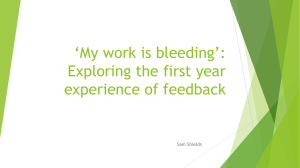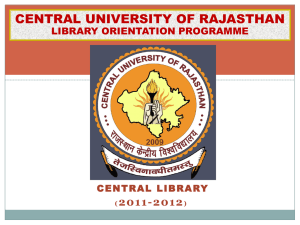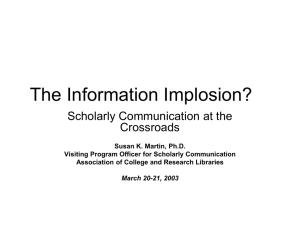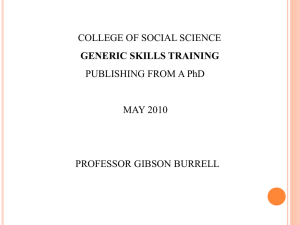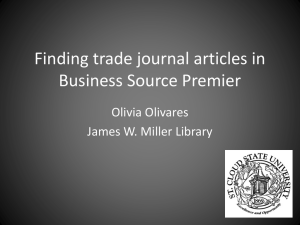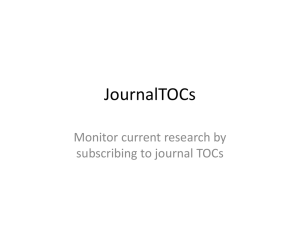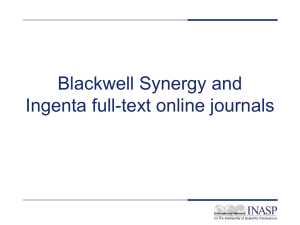Plotting an academic paper
advertisement
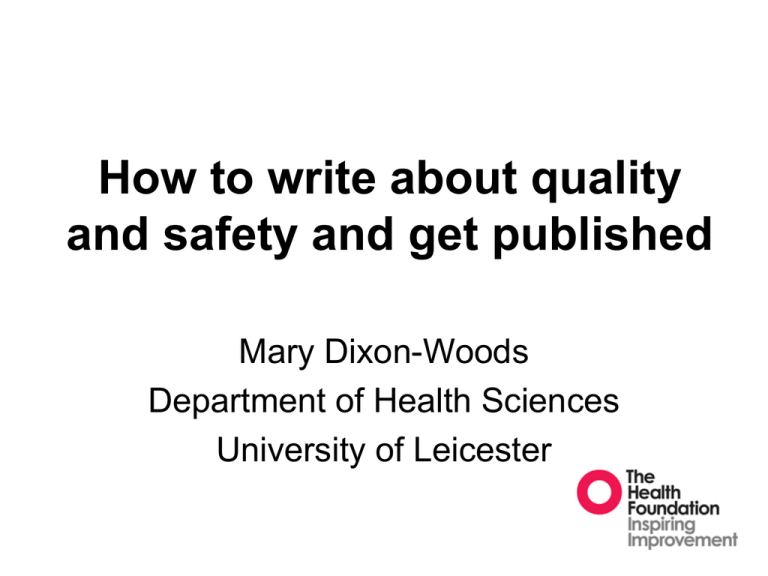
How to write about quality
and safety and get published
Mary Dixon-Woods
Department of Health Sciences
University of Leicester
Decide on your story
• What is the story you want to tell?
• Write the abstract first – but keep writing it
over and over and over
• Can you explain the story clearly?
– Imagine you are being interviewed on live TV
Where is the best place to
tell your story?
• Medical/health journals
– Good for exposure
– Helpful for healthcare professional careers
– Often short word limits, can be a bit frustrating for
some kinds of papers
– Decide between specialist/generalist journals
Specialist/generalist health
journals
• Big, high impact journals (NEJM, Lancet, JAMA
etc)
• Speciality-specific journals (e.g. Pediatrics,
Anaesthesia, Journal of Advanced Nursing,
Journal of Clinical Pharmacy and Therapeutics)
• Quality and safety journals (e.g. BMJQS,
Implementation Science, Joint Commission
Journal on Quality and Safety...)
Where is the best place
to tell your story?
• Social science journals
– Good for credibility
– Can be intellectually satisfying if you are a social
scientist
– Very demanding to write, long word limits
– Needs theoretical sophistication
– May be more limited in impact
Choosing a journal
• High impact/high status?
• Indexed on right databases?
• Going to reach your audience?
• Right requirements in terms of your story?
• Reasonable time to decision and publication?
Be aware of your audience
• If medical/health audience make sure there is a
key set of practical messages
• If social science audience need to demonstrate
mastery of theory
• If in doubt, explain concepts
• Always prioritise clarity
Fit the structure to the study
type
• IMRaD is the basic structure for most
health journals
• Guidelines cover many study types (e.g.
CONSORT for clinical trials)
http://www.consort-statement.org/
• http://squire-statement.org/ for quality
improvement reports
Don’t forget the abstract
• Often given little time or effort by authors
• But the busy editor is using it to screen
likely candidates
• It also sets the tone for the busy referee
• And it may be the only bit of your paper
that’s publicly, freely accessible
• So work hard on it!
Structuring a paper:
introduction
– Intrigue the reader. Set up a problem you are
going to solve.
– Don’t go on too long – get to the point quickly.
And don’t give a standard, boring introduction
that everyone has read before.
– Give us
• Something general about the importance of the
overall topic area.
• Introduction of the particular content or problem
being addressed by this particular paper
• Statement of precisely the purpose or research
question for the paper.
Introduction: Making the story
work
• Don’t just summarise previous literature
• Get hold of your voice and make that literature
work for your story
• There is no point in even mentioning literature
unless it contributes directly to your story
Structuring a paper: Methods
and Results
• Methods
– Clear, explicit, honest and accurate account.
– If you use technical terms, make sure you
understand them and only cite literature you have
read and understood.
• Results
– Use subheadings, tables, boxes as appropriate
– Be coherent and concise
– Generally don’t offer commentary at this stage in
health journals
Structuring a paper:
Discussion
– Begin with a summary, highlighting the issues you
want to draw out
– Acknowledge limitations
– Come to a conclusion, indicate policy or practice
implications and directions for future research
Get the writing right
• Good writing and good thinking are inseparable.
• Spelling, grammar, punctuation, and sentence
construction all really matter. Getting them wrong
damages your credibility.
• Avoid over-long, complex sentences. Avoid run-on
sentences. Avoid using “however” unless you are
absolutely sure you know what you’re doing.
.{;&?“@
! : “ , } ? ,]
Writing right
• Use plenty of sign-posting, but try to do it in a
light-handed way. Use plenty of sub-headings,
even if you end up deleting a lot of them later.
• Every para should contain a single idea, and
transition seamlessly to the next.
• Make points once. Don’t keep repeating them.
Structure, structure, structure
• Organising your material into a coherent
narrative is the biggest challenge
• Be ruthless – cut, cut, cut
• Only include stuff that works for your story
• Maintain a voice that is consistent throughout.
Be prepared to change
and change again
• May start off writing something but it
mutates into something else
• Constant redrafting
• Keep coming back to abstract
• Try getting story down to bullet points
Working in a team
• Fraught with challenges
• Decide on provisional authorship up front, but
be prepared to revise
• Different models
– Strong leader
– Federal (section-based)
Working in a team
• Make sure everyone sees and agrees final
version
• And agrees with any revisions subsequently
• Agree things like statement of contributorship
Authorship and contributorship
• International Committee of Medical
Journal Editors (ICMJE)
http://www.icmje.org/
• Good idea to describe every author’s
contribution, even if not required by the
journal
Preparing a submission
• Make sure you address journal-specific
requirements
– References in correct system
– Comply with any journal requirements
– Delete hangovers from previous submissions
• Make sure you get acknowledgements right
• Keep a note of when you submitted it; ok to start
hassling editorial assistant after about 3 months
– but do it nicely
Be prepared for harsh words
and rejection
• Major medical journals reject ~95% of
submissions
– Sometimes within hours of receipt
• Major social science journals reject about 80%
and up
• Only appeal if you really are sure of your
grounds
• Most articles are rejected three or four times
before getting published somewhere
Referees’ reports
• May seem very hurtful, esp first few times
• Try to move beyond emotional reaction
• Sometimes seem incompetent or perfunctory
• Often very helpful
• Sometimes (often?) the reports contradict each
other
Responding to
referees’ reports
• Amend your paper to address the points raised,
as appropriate
– Don’t feel you have to do everything they suggest
• Give a point-by-point explanation – helpful if you
number this. Indicate if there’s anything you
would give way on.
• Be respectful – make displays of deference
Next stages
• If rejected, think about where to go next
• If accepted, be very cooperative with copyediting and proofing
• Check re putting a pdf into your institutional
archive
• Put publication details on your website etc
• Check if press office (either journal or your
institution) would be interested
Things that go wrong
• Team fights over where to send paper
• Team cannot agree draft of paper
• Team cannot agree order of authorship
• You have a renegade on the team
• Someone wins a point but then it gets rejected
because referee supports other position
Plotting an academic paper
The 7 step programme
1.
2.
3.
4.
5.
6.
7.
Problem
Desire
Opponent
Plan
Battle
Knowledge
New level
1. Problem
• Show that there is some issue that really needs
tackling
• Introduce it in an attention-grabbing way if you
can
• Make it an interesting problem
– Show how it’s obstructing the achievement of
important goals
– Link it to a policy or practice objective
– Show how it affects people’s lives
2. Desire
• Your desire is to put the problem right
• Formulate your desire as a clear research
question
• At the early stages of a paper you may be
working up towards posing this question
• So use your literature strategically
A good research question
• Is clearly stated
• Is well defined (and will have defined
its terms in the lead-in phase)
• Is oriented to solving an empirical or theoretical
trouble
3. Opponent
• The thing that is standing in your way of
resolving the problem is (usually) that other
research has failed
• There is a gap in the literature
• And you’re the one to fill it – you’re the (wo)man
with the plan
Using the literature
• Everything you do has to work to establish the
problem, desire and opponent
• DO NOT simply list studies and what they say
– this is very boring and doesn’t help you build your
argument
• DO NOT start sentences with the name of the
author
– e.g. “Woodrow et al state that most patients avoid
taking tablets that are difficult to swallow.”
Marshall the literature effectively
• Identify ways in which the literature can be
organised
• Generate your own labels for these if needed
• Use devices such as numbering
– Four major approaches to explaining non-compliance
with infection control can be distinguished.
– One dominant way of understanding non-compliance
is to examine behaviours. In this article, we propose
an emphasis on values instead.
4. Plan
• State your aims clearly at the end of the
Introduction, having convinced us there’s really
a problem
• Now outline your plan
• This should be a good plan that is well suited to
addressing the problem
5. Battle
• The battle is your efforts to implement your plan
• It won’t always go perfectly
• So show how well what actually happened
matched your plan
– Report response rate and the characteristics of who
ended up in the study
– Tell us anything that might be relevant to
understanding plan implementation
6. Knowledge
• This is your results
• Present them authoritatively and clearly, in a
logical sequence – build a plot and keep us
interested
• Put things in tables if needs be, but then don’t
repeat the material again the text. And don’t say
“Table 1 reports…”
7. New level
• This is your Discussion
• Start by restating your main findings
• Reflect on the new level you’ve reached as result of your
plan and battle to address the problem
• Link to what is already known
• Acknowledge the limitations
• Tell us about the implications (what needs to be different
now?)
• Say what more needs to be done to sort the problem
The authorial voice
• This needs to be constantly present
• But not clumsy – you need to be confident and in control
of the material, steering us towards your argument
• Be assertive, be in charge, make us think you’re worth
listening to
• Use devices such as explaining what your argument is at
the beginning
– “we will argue that non-compliance is best understood
as a problem of legitimacy, rather than one of
unprincipled cognitive lapse”
Other plot devices
• Use a short, authorial interjection from time to
time
– “All three of these approaches are deficient in the way
they conceptualise non-compliance”
– “Soandso’s (1993) approach offers perhaps the most
thoroughly informed critique of the ‘cognitive lapses’
tradition”.
– “Soandso’s proposal does little to address the
problem that ‘cognitive lapses’ explain only a small
proportion of non-compliance.”
Sleights of hand
• When you need to acknowledge that there are
lots of ways of thinking about something, but
don’t want to go into them all
– “Among the many approaches to conceptualising
non-compliance, those that address professionals’
values are most persuasive.”
– “Non-compliance escapes straightforward definition.
For purposes of this study, we will adopt that used by
Soandso, in her influential analysis.”
The signs of an amateur
• Saying “in 1993, Soandso said that..”
• Using ‘dollops’ of literature
• Claiming the work is much more
important/significant/original than it really is
• Describing, not conceptualising
• Being too passive
Questions?


